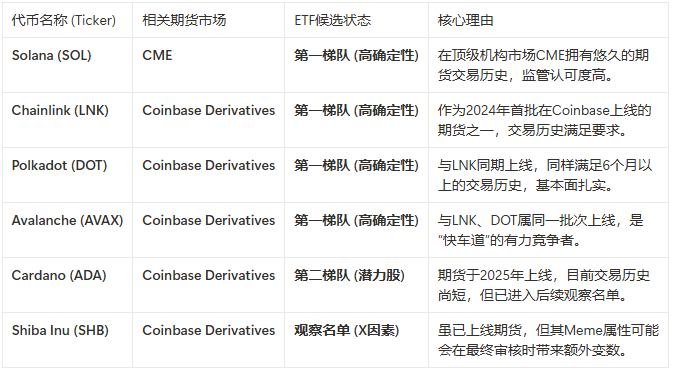The "Normandy Moment" of Crypto ETFs: New SEC Regulations Acquiesce to Staking Yields, Coinbase Emerges as the Biggest Winner
Written by: Luke, Mars Finance
The approval of the Bitcoin spot ETF in January 2024 is a successful "beach landing" for crypto assets to break into the traditional financial fortress. However, the real "Normandy moment" - the landing of the "main force" that will determine the future situation of the war and form an establishment and a large scale is quietly opening with a recent seemingly bland regulatory document.
Recently, the rule change proposals submitted by the Cboe BZX exchange and Nasdaq (SR-CboeBZX-2025-104, etc.) are trying to establish a "universal listing standard" fast lane for altcoins. This is not a small-scale reinforcement, but a carefully planned "institutionalized landing". Its core tactics are two: one is to open up a standardized highway to allow follow-up troops (altcoin ETFs) to enter continuously; Second, a "new weapon" has been quietly added to the arsenal - staking yields that are "acquiesced" by supervision.
In this magnificent picture of financial change, when we take a closer look at the geographical location of the "landing site" and the controllers of the "logistics supply line", a name emerges: Coinbase. The largest crypto exchange in the United States is inadvertently pushed to the throne of the "biggest winner" by this new set of regulations with its unparalleled ecosystem advantages.
From case-by-case approval to highways
Previously, the birth of any crypto ETF had to go through the SEC's long and rigorous "case-by-case approval", which was full of uncertainty. The new "Universal Listing Standard" is a game-changer, and at its core: any crypto asset is eligible to be listed in the "fast lane" as long as its futures contract has been stably traded in a CFTC-regulated market (such as CME or Coinbase derivatives exchange) for six months.
The SEC's intention is to establish a scalable regulatory framework, but objectively, this "decentralizes" some of its approval power. The new center of power, from the SEC office in Washington, has moved to the doorstep of those platforms capable of offering compliant futures trading.
While CME is one of them, it focuses more on large-cap assets such as Bitcoin and Ethereum. For the vast world of altcoins, the real "beachhead" is undoubtedly the Coinbase derivatives exchange. It has the flexibility and willingness to list more diversified altcoin futures. Therefore, the first and most critical hurdle for a project to make its token ETF has changed from lobbying SEC lawmakers to working to launch its futures products on Coinbase Derivatives.
The first wave of landing forces: the shortlist is clearly visible
This clear set of rules allows us to move away from pure speculation for the first time and directly lock in the list of the first "landing forces" based on a clear formula. These "vanguards" have completed the "pre-war drill" in the compliant futures market, with sufficient ammunition and just waiting for the charge to sound.
Based on this logic, the first list of altcoin ETF candidates most likely to be approved has jumped onto paper:
Players from the Coinbase camp include: Avalanche (AVAX), Chainlink (LNK), Polkadot (DOT), and even Shiba Inu (SHB), which is extremely popular in the market. Futures contracts for these tokens have been filed or listed on Coinbase Derivatives in 2024, and by the time the new regulations are officially passed, their "service" time will well exceed the six-month mandatory requirement.
-
The heavyweight from the CME camp is Solana (SOL), whose futures products have long been running stably on the institutional CME and have a strong compliance foundation.
-
Therefore, when the market is still hotly discussing "who will be the next to be approved", the answer is actually hidden in the public information of the exchange. This batch of assets will be the first wave of ETF products to hit Wall Street after the new regulations are passed. This will be followed by assets like Cardano (ADA), whose futures are launched a little later and form the "second echelon".

Why Coinbase is the "Chosen One"
If becoming an "access gate" is a strategic advantage brought by the new regulations, then the provisions on pledge directly point to huge commercial benefits. The power of this clause can be understood when we can foresee the emergence of a "Solana ETF with staking income" or "Polkadot ETF".
The new regulation 14.11(e)(4)(G) subtly states that ETF products that include staking income are allowed as long as the ETF issuer can ensure that 85% of the assets are ready to be redeemed at any time, or has a complete "liquidity risk management plan" in place for this purpose. This is equivalent to "acquiescing" to packaging the native income mechanism of the DeFi world into the most mainstream financial products on Wall Street.

And who are the biggest beneficiaries of this business? It's still Coinbase. As one of the world's largest and most trusted institutional-grade staking services, Coinbase Custody is the preferred partner for almost all ETF issuers. No matter which token in the above list is ETFIZED and staked, Coinbase will earn service fees and revenue sharing by providing custody and staking services, and its staking business unit will usher in explosive growth.
Taken together, the SEC's new rules are like a gift tailored to Coinbase's "full-stack" business model. It perfectly connects every link in the Coinbase ecosystem, forming a powerful business flywheel:
-
Futures Market (Entrance): Coinbase Derivatives has become the "qualification center" for ETFs, attracting all project parties eager to be accepted by the mainstream to come to the "pilgrimage", bringing trading volume and listing fees.
-
Staking and Custody (Engine): Coinbase Custody becomes the "core infrastructure" of staked ETFs, serving the underlying assets of future ETFs such as AVAX, SOL, DOT, etc.
-
Spot market (basic): The ETF subscription and redemption mechanism will bring massive trading depth and fee income to Coinbase's spot market.
-
Regulatory cooperation (moat): ETF issuers must sign a "surveillance-sharing agreement" with the underlying futures market, making Coinbase an indispensable "regtech" partner for Wall Street giants such as BlackRock and Fidelity in the altcoin space.
This series of advantages is intertwined, transforming Coinbase from a leader in the crypto industry to a "core hub" connecting the crypto world and traditional finance.
Conclusion: From "Spying on the SEC" to "Following Coinbase"
Just as the "Normandy landings" marked a turning point in the European battlefield of World War II, the proposal of the "Universal Listing Standard" also marked a turning point in the integration of crypto assets into mainstream finance. It heralds a new era: an era of altcoin ETFizations driven by clear rules that can be replicated at scale.
In this grand historical process, the SEC has inadvertently "crowned" a new king while solving its own regulatory problems through an ingenious institutional design. The market's focus may shift from speculating about the SEC's attitude day after day to focusing more pragmatically on Coinbase's next move - because every decision to list futures may be a clarion call for the next ETF to land on Wall Street with a clearly visible listing.
